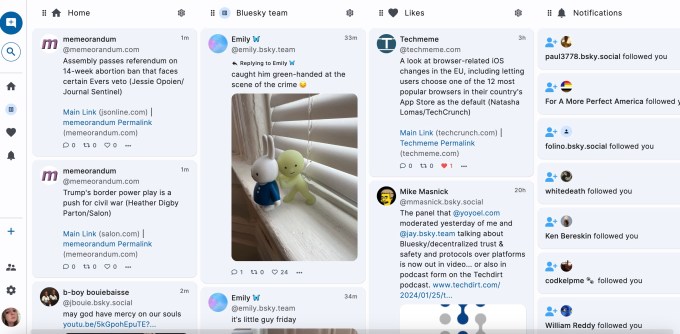A year ago, Bluesky was opening up to the public and was known as one of the many X competitors that emerged after Elon Musk acquired the network formerly known as Twitter. Today, Bluesky’s social network has grown to over 33 million users, while the technology it’s built upon — the AT Protocol (or ATProto for short) — is being used to develop dozens more applications designed to work together as part of an open social web.
The developers behind many of these apps attended the first conference dedicated to the AT Protocol, ATmosphere, held in Seattle last weekend. There, they learned what’s ahead for ATProto, what challenges still need to be overcome, and what other things they’ll need to think about as they build for this new social app ecosystem. Others attended online, watched the talks and presentations remotely, and participated in a growing Discord chat for community members.
The ATProto community is working to rebuild Web 2.0, an earlier version of the social web that included social media websites, blogs, wikis, video- and photo-sharing sites, and other collaborative and hosted services. Except this time around, the apps are being built on open technology, not siloed into centralized services that tend to be operated by tech giants.
Bluesky was the first of these services to emerge, but if the open social web movement has any staying power, it won’t be the last.
Below is a list of AT Protocol-based, consumer-facing apps that are either built on top of Bluesky or its underlying protocol, allowing users to take back control over their social networking experiences and personal data. Many of these are still in early development but showcase the potential for what’s ahead in this expanding ecosystem.
This is a work in progress! Apps are still being added. Feeling left out? Email sarahp@techcrunch.com. (Note that this list is focused on consumer-facing apps people can use now, not small projects or dev tools.)
Photo and video-sharing apps
Flashes

Flashes is an Instagram alternative based on Berlin developer Sebastian Vogelsang’s earlier app, Skeets, a Bluesky client. Launched publicly at the end of February, Flashes grabbed 30,000 downloads in its first 24 hours for offering a classic Instagram experience. Users can upload up to four photos or videos of up to 3 minutes in length, up from 1 minute previously, thanks to an update Bluesky released. The app offers photo filters, curated feeds from artists, custom feeds, and a Portfolio Mode where photographers can showcase their work.
Spark

Spark (originally called Reelo) is a video-first app that is built on top of the AT Protocol, not just Bluesky. That allows the app to differentiate itself with a broader feature set that will include support for longer videos, filters, effects, a music library, and, eventually, livestreaming.
Skylight Social
Built by Seattle-based co-founders Victoria (“Tori”) White and Reed Harmeyer, Skylight is built on top of Bluesky, offering features such as likes, follows, comments, and profile pages. Users can follow the app’s active development on its co-founder’s TikTok page as the team adds more features, including video support.
The app is in testing on iOS and Android.

Pinksky
Pinksky is another one of many apps trying to build an alternative to Instagram using ATProto. Built by developer Ramon Souza, the app is available on both iOS and Android and will focus mainly on photo-sharing, like classic Instagram did. The app offers similar features to Instagram, including user profiles, a feed of photos and videos, and a Stories section where posts remain visible for 24 hours.

Bluescreen (TikTok alternative)
Bluescreen, also built by Vogelsang, is an upcoming app that will focus on videos posted to the Bluesky social network.
Videos for Bluesky
The generically named Videos for Bluesky is another app built on top of Bluesky from “MszPro,” aka Hoshida Takiyoshi, an indie Japanese developer. Like others, Videos for Bluesky lets you browse videos posted to the Bluesky social network by vertically scrolling in a TikTok-like user interface with familiar Like, Repost, and Reply buttons.
Livestreaming
Streamplace

Streamplace is the first livestreaming video service built on top of the AT Protocol. The service, which was recently used to livestream the ATmosphere conference in Seattle, offers a familiar streaming experience with support for high-quality videos, livestreaming, clips, and uploads. All the video content is also cryptographically signed by creators and respects their consent preferences. It is built on the same public key infrastructure as decentralized social networks.
Founded by Eli Mallon, Streamplace was initially backed by his previous employer, Livepeer (another decentralized video platform), which operated a crypto treasury where funds are invested into other projects. That allowed him to get Streamplace off the ground. Now he sees potential in building out a technology that could appeal to creators like Twitch streamers, who would rather connect directly with fans through their own app or website instead of having to split their revenue with Twitch owner Amazon.
Feed builders
Graze
Graze is a startup that lets you easily build, customize, publish, and manage Bluesky feeds and, eventually, monetize them with ads, sponsored posts, and subscriptions. The service is working with the Bluesky firehose, aka the Jetstream, which includes all the public posts on the social network.
Surf

Flipboard’s newest app, Surf, lets you build your own custom feeds from across the open web, including not only Bluesky but also Mastodon, RSS, and more. That means you can mix in news articles, blog posts, podcasts, and YouTube feeds into the custom feeds you build in Surf, alongside social posts. You can then use Surf to browse your feeds and others from the community across a range of topics and interests. Surf is still in private beta testing, but a signup list is available.
SkyFeed
A web-based, TweetDeck-like client for Bluesky, SkyFeed lets you create a dashboard of your feeds and profiles. However, most of its users come to SkyFeed because it also offers an easy way for even nondevelopers to build custom feeds based on lists or regexes.
Communication / social discovery
Germ

Germ’s big idea is not just to offer an alternative to your phone messages, like Signal, but to build a social platform where you could discover and connect with others for any reason: marketplace exchanges, dating, social networking, and more. However, it would be one where you were in control of the data you were sharing and could stop that sharing at any time.
Currently an end-to-end encrypted messenger that you can download from the App Store, Germ lets you build and share multiple identities. Plus, you can start chatting with someone on Germ even if they don’t have the app installed, thanks to its use of Apple’s App Clips technology. This allows you to have a lightweight app experience on your iPhone before you download the full application from the App Store.
Germ was founded by writer and Stanford lecturer Tessa Brown (CEO) and former Apple privacy engineer Mark Xue (CTO). The team is now working on a Bluesky integration that would allow users to chat securely with their Bluesky friends.
Roomy

A peer-to-peer messaging app built on the AT Protocol, Roomy is similar in some ways to Discord but taps into open standards. For instance, ATProto is used for social discovery, while Automerge is used for peer-to-peer discovery. The app is backed by funding from Skyseed and is currently in alpha testing.
You can log into Roomy with your Bluesky account and direct message other users to engage in chats. The messages are encrypted, but this is an experimental project and not audited, so be aware. Plus, some non-encrypted metadata shows who you were talking to but not the contents of those messages. (In other words, don’t swap out Signal for Roomy yet.)
Social Trends
Dazzle.fm

Founded by former Stability AI engineer John Sabath, Dazzle offers a website that makes sense of the firehose of data from Bluesky and organizes it into categories, highlighting the trends across various topics. While much of the early discussion on Bluesky today leans political, Dazzle’s site can help you find other topics and conversations taking place.
Dazzle lets you give it instructions to tune the site to your own interests, too. You could ask it to show you a topic but without any posts featuring political discussions, for example. That means you could use Dazzle to show you local news, but not national politics, or you could keep your experience focused only on those who are posting with a positive sentiment.
The idea is that you’ll be able to switch between these different modes, generated using AI technology, without actually having to build custom feeds. Instead, you can just type in what you want to see (or not see) into a chat-like interface, then have Dazzle reconfigure itself to offer you posts that match whatever “vibe” you had just requested.
Sill

Link aggregation service Sill lets you keep up with what everyone’s talking about on alternative social media sites like Bluesky and Mastodon in one place. The service is similar to the older startup Nuzzel, which was acquired by Twitter as part of its deal for Scroll in 2021, then integrated into Twitter’s app. Popular with news junkies, Nuzzel helped users keep track of what everyone on Twitter was talking about, reading, and resharing that day.
Sill is also among the early adopters using Bluesky’s OAuth for the AT Protocol instead of app passwords, making it easier to log in. Once connected, you’ll see the most shared links across your services and the resulting conversations.
Frontpage

A decentralized and federated link aggregator built on ATProto, Frontpage offers a simple interface for organizing and upvoting interesting posts and links being shared across the social network. It also supports commenting and notifications.
Alternative Bluesky Clients
Skeets
Also by Vogelsang, Skeets is an alternative to Bluesky’s main app that’s optimized for accessibility and works well on both iPhone and iPad.
Deck.blue
Another TweetDeck-style web app, Deck.blue lets you fill your screen with columns featuring your Home feed, Notifications, custom feeds, lists, and more. The app also supports multiple accounts and the scheduling of posts.

Events
Smoke Signal
An event and RSVP management system, Smoke Signal is the Bluesky alternative to something like Eventbrite or Facebook Events. Built on top of ATProto, Smoke Signal supports OAuth, allowing users to discover communities and create and RSVP to events while also keeping hold of their own personal data.

Blogging
White Wind
A Markdown blogging service for the AT Protocol, White Wind lets you use your ATProto account to log in, then write in Markdown. The service includes tools for uploading images, previewing your post, and more, with everything stored in your account’s PDS (personal data service). When you post on Bluesky, those replies are included on your blog automatically.

Analytics
BlueSkyHunter
Largely a growth and analytics toolset for Bluesky, BlueSkyHunter also offers a way to tap into trends on the social network. One section in the app called Viral Posts showcases the more popular posts. This could help content planners pick up on trends and memes or find templates that are popular with other users that they could adopt.
Fedica
Fedica offers an online dashboard that allows you to compose and schedule posts across social networks, including Bluesky, Threads, X, Mastodon, and Pixelfed, among others. It also supports more traditional social apps like Facebook, Instagram, TikTok, Pinterest, and YouTube. Included in its plans are a variety of features for social listening, tools for tracking hashtags, keywords, and post reach, as well as those for follower analysis.








